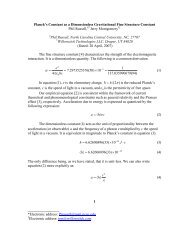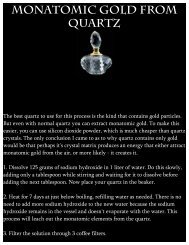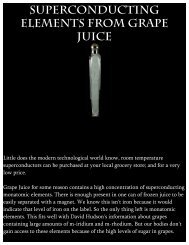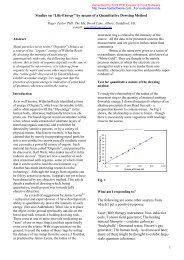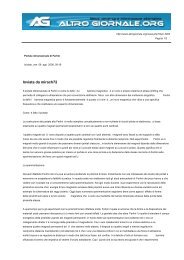Viktor Schauberger
Viktor Schauberger
Viktor Schauberger
Create successful ePaper yourself
Turn your PDF publications into a flip-book with our unique Google optimized e-Paper software.
and 22,5'. Unbelievably some will think - however exactly these right-angled flight changes are<br />
for so-called uFOs absolutely typical flight behavior.<br />
After the success of the small RFZ 2 as long-range reconnaissance aircraft the Vril society got its<br />
own testing ground in Brandenburg. At the end of of 1942 flew the easily armed flight disk<br />
"VRIL-1-Jaeger". It was 11,5m in the diameter, a single-seater, had a "Schumann Levitator<br />
drive" and a "magnetic field Impulsor control". It reached speeds of 2,900 up to 12,000 km/h,<br />
could accomplish at full speed changes of flight in the right angle, without the pilots were<br />
impaired of it, was weather-independent and had an universe ability of 100%.<br />
By Vril 1 and gave also several two-seat variants equipped with a glass dome were built for 17<br />
pieces. Likewise to this time its own project, V-7 developed. Under this designation several<br />
flight disks built however with conventional jet propulsions. On the bases of ANDREAS EPP the<br />
RFZ 7, a combination of a levitierenden flight disk with jet propulsion developed. On this the<br />
groups of developments worked SCHRIEVER HABERMOHL and MIETHE BELLUZO. The<br />
RFZ 7 had a diameter of 42m, went however with a landing in Spitzbergen to break. Later<br />
however a copied RFZ 7 was photographed outside of Prague. According to statement of<br />
Andreas Epp should be equipped this with atomic sprengkoepfen and bombarded New York.<br />
In July 1941 built and HABERMOHL a perpendicularly starting round airplane with jet<br />
propulsion, which exhibited however heavy lack. One developed however a further "electrical<br />
gravitation flight gyroscope" with "Tachyonen drive" was more successful. Whereupon the RFZ<br />
7 T, built by, followed Habermohl and Belluzo and likewise fully functionally. The V-7 flight<br />
disks was however, compared with the Vril and Haunebu disks to describe rather as a kind toy.<br />
Within the SS there was a group, which was concerned with the production of alternative energy,<br />
the SS-E-IV = RESEARCH CENTER IV the BLACK SUN, whose main objective it was, to<br />
make Germany independent of foreign crude oil. Hans Coler the "THULE ENGINE" developed<br />
S SE-IV from the existing Vril engines and the Tachyonenkonverter of captain, which was<br />
designated later than THULE TACHYONATOR.<br />
In August 1939 the first RFZ 5 started. It was a moderately severe armed flight gyroscope with<br />
the strange name "HAUNEBU 1". It had a crew of eight men, measured 25m in the diameter,<br />
reached at the beginning a speed of 4,800 km/h and later up to 17,000 km/h. It was equipped<br />
with two 6 cm KSK (force jet cannons) in rotating turrets and four MK 106 and had a space<br />
ability of 60%.<br />
At the end of of 1942 had likewise developed the "HAUNEBU IL". The diameter varied from<br />
26 to 32m and in the height between 9 and l 1m. It could transport a crew between 9 and 20<br />
persons. It was propelled with a Thule Tachyonator and reached at perigee a speed of 6,000<br />
Km/h. It was universe suited and had a range of 55 flying hours.<br />
Plans for the VRIL-7-Grossraumschiff with a diameter of 120m already existed, should<br />
transport whole crews at this time.<br />
Short time was flown later the "HAUNEBU III", the absolute piece of splendor of all disks,<br />
finished with 71m diameter and also filmed. It could transport a crew of 32 men, had a range in<br />
flight duration of over 8 weeks and reaches a speed of at least 7.000 km/h (after documents from<br />
SS Geheimarchiven up to 40,000 Km/h).



